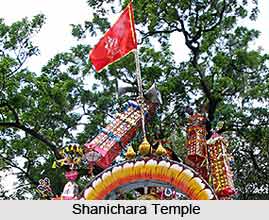 Shanichara temple is one of the most famous temples in the district of Morena in Madhya Pradesh state. The Hindus consider Shani or Saturn in great awe and respect. In fact, Saturn is the only deity whose benign glance is believed to bestow prosperity, while a fierce look can cause unparalleled misfortune on the object of its attention. Thus devotees flock to appease the God every Saturday. The Shanichara temple in the district of Morena district at Aeti is rather special, though it doesn`t appear so from the outside. It houses the original black idol of Shani brought from Lanka (now known as Sri Lanka). The Shanichara temple is about thirty seven kilometers from Morena en route to Banmore (NH3) Aiti Village. The Shanichara temple is about eighteen kilometers from Gwalior en route to Padhavali, Mitaoli and Bateshwar.
Shanichara temple is one of the most famous temples in the district of Morena in Madhya Pradesh state. The Hindus consider Shani or Saturn in great awe and respect. In fact, Saturn is the only deity whose benign glance is believed to bestow prosperity, while a fierce look can cause unparalleled misfortune on the object of its attention. Thus devotees flock to appease the God every Saturday. The Shanichara temple in the district of Morena district at Aeti is rather special, though it doesn`t appear so from the outside. It houses the original black idol of Shani brought from Lanka (now known as Sri Lanka). The Shanichara temple is about thirty seven kilometers from Morena en route to Banmore (NH3) Aiti Village. The Shanichara temple is about eighteen kilometers from Gwalior en route to Padhavali, Mitaoli and Bateshwar.
According to the legend, Shanideva was held prisoner by the demon-king Ravana (the king of Lanka), in the great Hindu epic of Ramayana. The dusty village of Aeti came into being only after the establishment of the Shanichara temple. Earlier it was just a barren hilltop filled with some trees.
A grand prayer is organized on every Saturday at this temple and devotees in large numbers take part in this prayer. A grand puja or prayer is held here every Amavasya Shanivar (moonless Saturday night), which attracts a large number of devotees from different parts of the district as well as from various other parts of the state and outside. It is believed that Parikrama of `Shani Parvat`, a mountain of 14 kilometres perimeter, relieved people from the curse of Shanideva. Special narrow gauge trains operate from Agra, Gwalior, Jaipur, Vadodara and some other cities to bring devotees to this temple.
Just outside the stone temple of Shanideva is a statue of the monkey-god Hanuman. It depicts Lord Hanuman with a dagger tied to his waist stepping on another monkey. A very curious practice is observed here; worshippers leave behind their shirts and shoes or have their hair cut in the belief that any curse that might have been cast on them will disappear along with their locks. People normally dreaded of the curse of Shanideva as it affects them for two-and-a-half or seven years. It brings misery and misfortunes but if Shanideva or Saturn planet is happy then it fetches fortunes.
There are suitable water arrangements being made for devotees for bathing purpose through fountains outside the shrine premises. Oil, which is offered to Shanideva, would be allowed in plastic packets rather in bottles and would be offered through a long pipe which ends over the deity. The pipe would be laid from the main gate of temple to the sanctum sanctorum.





















